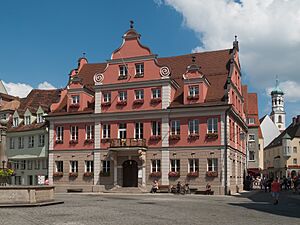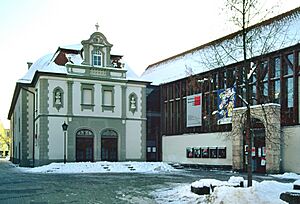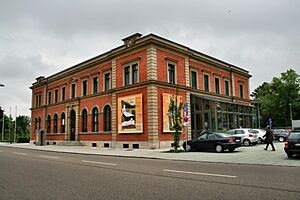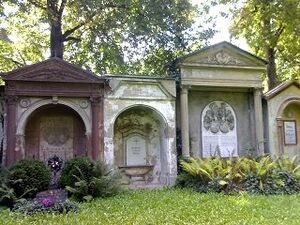Memmingen facts for kids
Quick facts for kids
Memmingen
|
|||
|---|---|---|---|
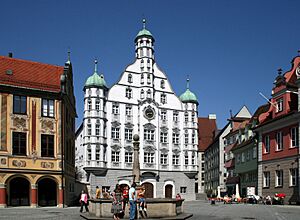
The Renaissance town hall of Memmingen
|
|||
|
|||
| Country | Germany | ||
| State | Bavaria | ||
| Admin. region | Swabia | ||
| District | Urban district | ||
| Elevation | 601 m (1,972 ft) | ||
| Population
(2022-12-31)
|
|||
| • Total | 45,857 | ||
| Time zone | CET/CEST (UTC+1/+2) | ||
| Postal codes |
87700
|
||
| Dialling codes | 08331 | ||
| Vehicle registration | MM | ||
| Website | Memmingen.de | ||
Memmingen is a lively town in Swabia, Bavaria, Germany. It's an important place for business, education, and government in the Danube-Iller area. To the west, the Iller river flows, marking the border with another German state, Baden-Württemberg. On its other sides, the town is surrounded by the Unterallgäu district.
About 42,000 people live in Memmingen, making it the fifth-largest town in the Swabia region. Its history goes all the way back to the Roman Empire. The old town is very special, with many old courtyards, castles, and grand houses. It's one of the best-preserved old towns in southern Germany. Memmingen is also a key transport hub because it has good connections by road, train, and even an airport.
Because it's so close to the beautiful Allgäu region, Memmingen is often called the "Gateway to the Allgäu." The town's motto is "Memmingen – a town with perspectives," meaning it's a place with a bright future. Recently, it's also been known as "Memmingen – the town of human rights." This is because the Twelve Articles, which are seen as one of the first written sets of human rights in Europe, were created here in 1525. Every four years, Memmingen hosts the huge Wallensteinfestspiel. This event has about 4,500 participants and is the biggest historical re-enactment in Europe. It remembers when the famous general Wallenstein and his troops visited in 1630.
Contents
History of Memmingen
People believe that a small Roman military town, possibly called Cassiliacum, once stood where Memmingen is today. Later, in the 5th century, a settlement of the Alemanni people was built. By the 7th century, a palace belonging to the king of the Franks was located here.
Memmingen became important for trade because of two main roads. The "salt road" connected it to Bohemia, Austria, and Munich. Another key route, the "Italian road," went from Northern Germany to Switzerland and Italy. These roads helped Memmingen grow as a trading center. In the Middle Ages, the town was known as Mammingin. In 1158, Duke Welf VI officially founded the town. In 1286, Memmingen became an Imperial City. This meant it was very independent and only answered to the Holy Roman Emperor, not to any local duke or lord.
In the early 1500s, during the Protestant Reformation, a preacher named Christoph Schappeler was very important in Memmingen. He supported the rights of peasants, which drew many to the city during the German Peasants' War. Memmingen adopted new religious ideas, first the Tetrapolitan Confession and then the Augsburg Confession.
A very important document called The Twelve Articles was written in Memmingen in early 1525. It was probably written by Schappeler and Sebastian Lotzer. This document was a request for peasant rights, using ideas from Martin Luther. Within two months, 25,000 copies were shared across Europe. These articles are considered some of the first human rights documents in the world, after the Magna Carta in England.
In the 1630s, Memmingen was a key location during the Thirty Years' War, a big conflict in Europe. The famous general Wallenstein stayed in the town when he was removed from his command. From 1632, the Swedish army briefly occupied Memmingen, using it as a base. In 1647, Imperial forces surrounded the Swedish soldiers, and the town surrendered after two months.
After Germany was reorganized in 1802, Memmingen became part of Bavaria. The town's economy struggled in the 19th century. However, things improved when a railway was built along the Iller River. Since World War II, Memmingen has grown a lot, with its economy doing better than the average for Bavaria.
Memmingen's Location
Memmingen is located on the western edge of Bavaria, right by the Iller River. It's about 50 kilometers south of Ulm and 100 kilometers west of Munich. The area around Memmingen is called Unterallgäu, which is part of the Mittelschwaben region. As mentioned, Memmingen is often called the "Gate to the Allgäu" because of its location.
Getting Around Memmingen
You can reach Memmingen easily by car using the A7 and A96 motorways. The Memmingen station is a train hub, connecting Munich and Lindau, and also the Ulm–Oberstdorf railway. The town also has its own public and international Memmingen Airport nearby.
Memmingen's Economy
Most of the businesses in Memmingen are small and medium-sized businesses. Some of the companies located here include:
- Alpine Hydraulik GmbH
- Berger Holding
- Dachser Logistics
- Gebrüder Weiss
- Gefro Reformversand Frommlet
- Hans Kolb Wellpappe
- Goldhofer
- Magnet-Schultz
- Memminger Brauerei
- Metzeler Schaum GmbH
- Pfeifer Holding
- Rohde & Schwarz
Culture and Fun Things to See
Historic Festivals in Memmingen
Every year, Memmingen celebrates the Fischertag (Fisherman's Day). This festival brings back old medieval traditions. The town brook is emptied and cleaned, and a "Fisherman's King" is chosen. This king is the person who catches the heaviest trout among almost 1,200 fishermen! Up to 40,000 people come to this festival each year to take part or just watch.
Every four years, Memmingen also re-enacts the events from Wallenstein's visit in 1630. This is Europe's biggest historical festival, called the Wallensteinfestspiele (Memmingen).
Theatre in Memmingen
Theatre has a long history in Memmingen. Even in the Middle Ages, people wrote about different theatre shows. In 1937, the Landestheater Schwaben (State Theatre of Swabia), or LTS, was founded. After World War II in 1945, the LTS was one of the first theatres in West Germany to start performing again. Shows happen in the Town Theatre, the theatre at the Schweizerberg, the Kaminwerk cultural center, or in other parts of Memmingen.
Another theatre, the Parterretheater im Künerhaus (PIK), was started for amateur actors and young musicians. The Kaminwerk also hosts big plays by amateur groups.
Museums in Memmingen
The biggest museum in Memmingen is the Town Museum at the Hermannsbau. It tells the story of the town in its historical rooms. There's also a section about the Jewish community in Memmingen, many of whom were forced to leave or were killed in 1939. A piece of the Torah from the destroyed synagogue is on display there. The Freudenthal/Altvater Homeland Museum is also part of the town museum. It's for refugees who settled in Memmingen.
The Strigel- and Antoniter-Museum are at the Antonierkloster. They show wood carvings and paintings by the Strigel family of artists. They also have an exhibition about the work of the Hospital Brothers of St. Anthony. This museum opened in 1996.
Thanks to donations, the MEWO-Kunsthalle opened in 2005 in the old post office building. This museum has artworks by Memmingen artists Max Unold and Josef Madlener. It also shows many modern art exhibitions. This art gallery is quite special for the region. The former Kreuzherren monastery is used for changing art shows.
Music in Memmingen
Organ concerts in the churches of St. Martins and St. Josef are well-known in the area. You can also enjoy chamber music in the former Kreuzherren monastery and other buildings in Memmingen.
The town has many pubs, restaurants, wine taverns, and cafés, plus some discothèques. The cultural center Kaminwerk (Chimney factory) is a popular spot for concerts, theatre, movies, readings, and special parties.
Famous Buildings in Memmingen
Memmingen is a great place for tourists because much of its medieval old town survived World War II. You can see ten town gates and towers, and about two kilometers of the old town wall. The old town has many interesting houses that belonged to rich families, some built in the baroque style. There are also picturesque streets with the Stadtbach (town river) flowing beside them.
The medieval market square is surrounded by beautiful buildings. These include the Town Hall, built in the renaissance style, the Großzunft (Guildhouse), and the painted Steuerhaus (tax house).
St. Martin's church is also famous. It's built in the Gothic style and has a choir that is over 500 years old. The Hospital Brothers of St. Anthony monastery (Antonierkloster) was restored in 1996. It's the oldest, best-preserved, and biggest of its kind.
The probably oldest church in town is Unser Frauen (Church of Our Lady), also called Frauenkirche. It has important frescos from the 15th and 16th centuries. Other sights in Memmingen include the Seven Roof House, the baroque Kreuzherren monastery, the Salzstadel (salt barn), and the Kramerzunft (shopkeepers guild), also known as the Twelve-Article-House. A lesser-known spot is the Bismarck tower in the west of Memmingen. Next to the tower is the new soccer stadium, built in 2007.
Parks and Green Spaces
Green areas have been created all along the old town wall. The old ditches were filled in and turned into parks with trees, some over 150 years old. These parks include Hubergarten, Zollergarten, Ratzengraben/Zollergraben, Kohlschanze, Reichshain, Kaisergraben, Hohe Wacht, Westertorplatz, and Grimmelschanze. Most neighborhoods also have their own smaller parks. There's also the town park in the New World, which was once the site of a big garden show. The old and forest cemeteries are also used as parks.
Cemeteries
In the Middle Ages, Memmingen had four cemeteries. They were located around St. Martin's Church, the Church of Our Lady, the Kreuzherren monastery, and the Scottish monastery. These were closed in 1530. A new cemetery, the Old cemetery, was then opened at the former Scottish monastery. This one was closed in 1930.
When the Old Cemetery closed, a new Forest Cemetery was opened in the east of Memmingen. There are also cemeteries in the districts of Amendingen, Steinheim, Buxach, Volkratshofen, Ferthofen, and Dickenreishausen. A Jewish cemetery is also located in the east of the town.
Twin Towns and Friendly Cities
Memmingen has special connections with other towns around the world, called "twin towns" or "sister cities":
Friendly Cities
Memmingen also has friendly relations with:
 Colmar, France (1965)
Colmar, France (1965)
Famous People from Memmingen
Many notable people have come from Memmingen, including:
- Bernhard Walther (1430–1504), a merchant, thinker, and astronomer
- Bernhard Strigel (1461–1528), a painter known for portraits and historical scenes
- Johann Heiss (1640–1704), a painter
- Gertrud Otto (1895–1970), an art historian
- Franz Roth (born 1946), a footballer
- Heinrich Bedford-Strohm (born 1960), a Lutheran bishop
- Holger Badstuber (born 1989), a footballer
- Timo Gebhart (born 1989), a footballer
- Sergejs Boldaveško (born 1970), a hockey player
- Mario Götze (born 1992), a footballer
Memmingen's Climate
| Climate data for Memmingen, elevation 614 m (2,014 ft), (1991–2020) | |||||||||||||
|---|---|---|---|---|---|---|---|---|---|---|---|---|---|
| Month | Jan | Feb | Mar | Apr | May | Jun | Jul | Aug | Sep | Oct | Nov | Dec | Year |
| Mean daily maximum °C (°F) | 2.8 (37.0) |
4.4 (39.9) |
9.1 (48.4) |
13.9 (57.0) |
18.2 (64.8) |
21.7 (71.1) |
23.6 (74.5) |
23.4 (74.1) |
18.5 (65.3) |
13.4 (56.1) |
7.0 (44.6) |
3.4 (38.1) |
13.3 (55.9) |
| Daily mean °C (°F) | −0.3 (31.5) |
0.2 (32.4) |
4.1 (39.4) |
8.2 (46.8) |
12.6 (54.7) |
16.2 (61.2) |
18.0 (64.4) |
17.4 (63.3) |
12.9 (55.2) |
8.6 (47.5) |
3.5 (38.3) |
0.5 (32.9) |
8.5 (47.3) |
| Mean daily minimum °C (°F) | −3.4 (25.9) |
−3.4 (25.9) |
−0.3 (31.5) |
2.6 (36.7) |
7.1 (44.8) |
10.7 (51.3) |
12.3 (54.1) |
11.9 (53.4) |
8.2 (46.8) |
4.8 (40.6) |
0.2 (32.4) |
−2.6 (27.3) |
4.0 (39.2) |
| Average precipitation mm (inches) | 51.5 (2.03) |
45.9 (1.81) |
57.9 (2.28) |
64.3 (2.53) |
108.5 (4.27) |
124.6 (4.91) |
118.9 (4.68) |
120.3 (4.74) |
80.1 (3.15) |
65.7 (2.59) |
62.0 (2.44) |
63.9 (2.52) |
963.6 (37.95) |
| Mean monthly sunshine hours | 66.3 | 88.5 | 127.2 | 165.5 | 196.6 | 205.3 | 232.5 | 213.4 | 156.3 | 113.3 | 67.7 | 51.2 | 1,683.8 |
| Source: Data derived from Deutscher Wetterdienst (sun 1981–2010) | |||||||||||||
See also
 In Spanish: Memmingen para niños
In Spanish: Memmingen para niños





